Surfing demands some serious strength, commitment and stamina – and that’s just to get the wetsuit on. By the time I hit the beach, I’m already half-knackered from squeezing myself, neck-to-ankle, into a sausage skin of neoprene. It’s my first-ever surf lesson and Rip Curl’s new CEO, Brooke Farris, has brought me to the reassuringly named Cosy Corner at the south end of the Torquay front beach; there’s barely a ripple on the sea below.
We kick off with a few practice pop-ups on the sand, jumping from belly to feet in what should be one smooth movement but, in my case, looks more like an artless wombat-style scramble. “Do you do yoga?” asks Farris, a former Australian surfing champion, and my heart sinks. It turns out a pop-up is a kind of reverse half-burpee/warrior-pose combo, executed in one second flat on a wobbly surface – requiring balance, pre-pandemic fitness and pre-baby core strength.
The ocean on this 15-degree spring day on Victoria’s Surf Coast may not be much rougher than bathwater, but I still somehow squeal like a toddler with every wave I tackle, popping only halfway up and promptly keeling over in the shallows. All dignity gone, I eventually make it onto my knees and glide, arms outstretched, for a triumphant five seconds, after Farris gives the board a hefty shove from behind. It feels like a minor miracle. As Farris says, the joy is in “riding nature’s energy”, whether you get to your feet or not, and there’s no denying it’s great fun – even for someone who’s way more girlie swot than surfie girl.
There are surely few things cooler than female surfers, yet even they struggled to break into the boys’ club that was board-riding 30 years ago. The barriers have since crumbled and people of all ages and persuasions are now sharing the breaks, especially since pandemic lockdowns have lured even more Australians into the water.
As if reading the room, global surf giant Rip Curl has recently appointed the first female CEO in its hypermasculine 52-year history. Although not an affirmative-action move by any measure – Farris is a well-respected figure in the surfing world and was an obvious choice – it does seem to herald a new, more inclusive era.
“Elevating people like Brooke into powerful positions is a sign that surfing is moving away from its gender-bullying past and understanding there’s strength in diversity.”
“It’s hard to avoid the idea that it signifies a hell of a lot,” says renowned surfing writer Nick Carroll, who took out his second national surfing title in 1981 – the same year that Puberty Blues hit cinemas and exposed the casual, intransigent misogyny in Australia’s surf culture. “The willingness of the sport to elevate people like Brooke into powerful positions is this incredibly pleasing thing – a sign that surfing is moving away from its gender-bullying past and understanding that there’s strength in diversity.”
Layne Beachley reckons it’s about time. Growing up on Sydney’s Manly Beach, the 49-year-old seven-time world surfing champion was routinely pushed off her board, splashed in the face and told she didn’t belong among the boys. The message was much the same from the surf industry: too many male surfers have left the pro circuit and landed plum jobs beyond their abilities, she says, while capable women have been denied the same opportunities. So when Farris called Beachley to share the news of her CEO gig, they were both in tears.
“It’s extremely significant,” says Beachley, chair of Surfing Australia. “It’s also disappointing that it’s so significant, considering how much women’s surfing has added to the surfing industry. It’s just rewards for the commitment, work ethic and passion that Brooke has, for not only the sport of surfing but also for the betterment of it.”
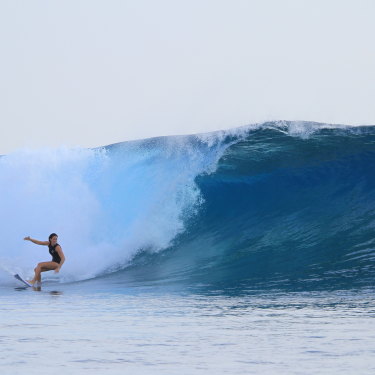
Brooke Farris surfing in Fiji.
On a sunny Monday morning, a couple of hours before our surf, 41-year-old Farris greets me at the glass front door of her modern, four-bedroom Jan Juc home, accompanied by her ultra-excitable caramel cavoodle named Western (as in Australia, Farris’s home state). Bells Beach – the 1973 birthplace of Australian pro surfing – and Rip Curl’s Torquay HQ are both about five minutes’ drive away. Tastefully decorated Scandinavian-style, the spare, light-filled house where the single CEO lives is all black, white and wood, with a computer on the dining table and a front deck overlooking the coastline.
The only nod to surfing I see is a glossy red Mark Richards 5′10″ 1980 Retro Twin Fin surfboard propped up against a wall in a spare bedroom – a 40th birthday present that’s yet to be christened. “I knew I was in good company,” says Farris, “when Mick Fanning also got an MR twin-fin for his 40th.”
Wearing Rip Curl jeans and a white T-shirt, Farris sits cross-legged on a grey sofa, with Western in her lap until he’s banished for bad behaviour. The angry red scar along her left ankle, she explains, is from the broken fibula she suffered in a mountain-bike accident in Tasmania last year. Known as Faz among her colleagues, Farris moved to Torquay to join Rip Curl 11 years ago and has since worked across the company, from events and marketing to digital and retail, but perhaps her training really began decades earlier, catching waves with her two older brothers at Perth’s Watermans Bay, where she thrived as “one of the boys”.
Loading
The daughter of a teacher and a real estate agent who separated when she was seven, Farris grew up in a family that divided its weekends between Perth’s beaches and sporting fields. With two footy-playing siblings and a grandfather who coached the West Perth Aussie rules team, Farris suspects she might have ended up in the AFLW had it existed in the 1990s. Instead, at the age of 13, she entered a high-school surfing comp and was thrilled when she beat all the older girls. “I enjoyed winning,” she says, “and being good at something.” By 15, Rip Curl was sponsoring her.
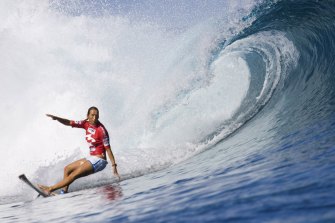
Layne Beachley (pictured here in 2006) established a $100,000 women’s event.Credit:Getty Images
Farris would win two national championships, but a world title was never the endgame. “She lacks that competitive mongrel,” says Beachley. “She’s too empathetic. She likes to bring the best out in others before she brings it out in herself.” For Farris, surfing was a way to hang out with friends and see the world, but her career ambition was to be a sports journalist. She wrote surfing stories for The West Australian as a teenager and began an arts degree at Curtin University before heading overseas to have a crack at the qualifying pro tour.
In 1999, Farris was at the US Open of Surfing at California’s Huntington Beach – a nervous 18-year-old crashing at the home of a friend of a friend, pro surfer Jodie Nelson – when she met then world-number-one Beachley, who was eight years older than her.
Nelson and Beachley went to Mexico on a surf trip and Farris tagged along, bonding with Beachley over their mutual love of big waves. Later, when she stayed with Beachley in Hawaii, the pair would bodysurf at Sunset Beach when it was closed for being too dangerous. Without flippers or goggles, they’d let a rip drag them out to sea and then swim across the current into the impact zone of 15-foot waves, just for the adrenalin rush. This could be courage or lunacy, but Farris paints it more as an exercise in self-improvement. “The ability to take the waves on, to adapt to change, that willingness to be beaten down and come back up and keep pushing – that just becomes inherent in how you do things,” she says. “It’s resilience and agility, and tactical in a way.”
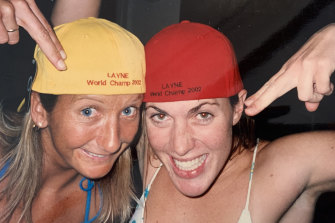
Farris (at right) with world champion Layne Beachley in 2001 (amused by their caps, which were mistakenly printed with the year 2002).Credit:Courtesy of Brooke Farris
In 2002, Farris moved to Sydney to become Beachley’s PA, retiring from competitive surfing later that year after coming third in the national titles. For almost six years, Farris managed the world champion’s life, helped set up her Aim For The Stars foundation – which gave out $1 million in grants to help women achieve their dreams – and established the $100,000 Beachley Classic, the world’s richest women’s surfing event. Says Farris: “Nothing stands in Layne’s way, so what she wanted to do, she would say it and she would do it.”
“Brooke was essentially the CEO of my life. She used to shy away from things that were difficult until I made her do them, but it broadened her skill set.”
Loading
For a 21-year-old, it must have been daunting. “She was essentially the CEO of my life,” says Beachley. “She used to shy away from things that were difficult until I made her do them, and I know that that challenged her, but it also broadened her skill set, like managing my finances. She showed a lot of initiative.” Beachley remembers Farris working so late setting up for the Classic, she slept at the event site on a beanbag. Living and working together, the two women became close friends; when Beachley went on her first date with now-husband Kirk Pengilly, for instance, Farris drove the couple to Dee Why RSL for ten-pin bowling.
“She just became an integral part of my family,” says Beachley. Eventually, though, the Association of Surfing Professionals (now the World Surf League) poached Farris to be its women’s tour manager. At the ASP, she proved herself nothing if not a loyal employee: at the 2007 Rip Curl Pro at Bells Beach, when Beachley swore during a live interview while having a go at one of the commentators for throwing her off her game, Farris sent Beachley an email, threatening to fine her friend for bringing the sport into disrepute. “I actually sent her the email a little while ago and went, ‘You remember this?’ ” says Beachley, laughing. “She was very embarrassed.”
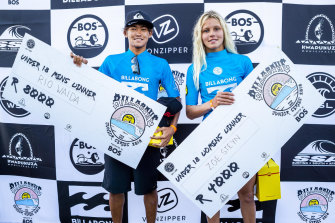
Soon after the male victor of the 2018 Ballito Pro Junior received twice the female’s winnings, prize figures were equalised.
In her three years as ASP’s women’s tour manager, Farris managed to up the women’s prize purse by 40 per cent, adding momentum to the push for pay equality.
Farris left her job in 2010 to join Rip Curl. In 2018, a photo of the Ballito Pro Junior winners – the female holding a cheque for $4000 and the male holding
one for double that – went viral. Soon after, the World Surf League’s first female CEO, Sophie Goldschmidt, declared that prize money for men and women would be equal from 2019.
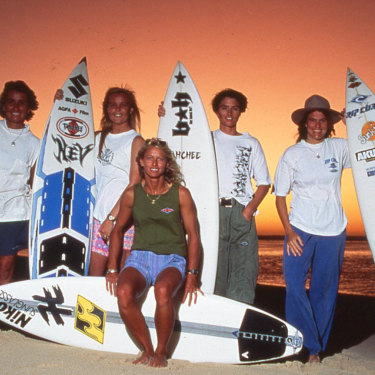
This year’s Girls Can’t Surf documentary tells of women’s fight to be taken seriously as surfers.
The rocky, 40-year road to that historic announcement is the subject of an Australian documentary released earlier this year, Girls Can’t Surf, which celebrates the renegade female surfers of the 1980s and ’90s, and chronicles their wrangles with a sporting world that refused to accept them. Among the indignities they faced, women surfers were often sent out to compete when the waves were considered too poor for the men, or when the blokes were on their lunch break. In 1989, the OP Pro in California dropped the women’s competition altogether – but of course kept the bikini contest – until a public outcry overturned the decision.
Loading
Female athletes were also made to wear ludicrous high-cut swimsuits that looked more at home in a Jane Fonda workout video. In one memorable grab from the doco, Western Australian surfer Jodie Cooper recounts competing in the impractical one-piece and copping a brutal impromptu “enema” in the waves, like “a bayonet up my bum”. When it came out later that Cooper was gay, she was dumped by her sponsor, while 1990 world champion Pam Burridge apparently put up with men’s unwanted advances for fear of being labelled a lesbian.
In contrast, the male surfers were treated like rock stars, and they weren’t about to cede the spotlight. By the turn of the ’70s, the happy-go-lucky Gidget days were over; surfboards had become shorter and harder to ride, marking a shift in the sport.
“If you look at surf movies of the early ’70s,” says Carroll, “what you see is a bunch of young men just swaggering about in the waves. Holy shit, you’re 22, you’ve got an amazing new kind of surfboard, you’re in Hawaii at Sunset Beach, and you just feel like you’re a god. So they all surfed like that – like, ‘Check me out!’ Surfing got super-macho and … that was the surf culture in the ’70s and ’80s. It was a real closed shop.”
“If you look at surf movies of the early ’70s, what you see is a bunch of young men just swaggering about in the waves … Surfing got super-macho.”
In the final scene of Puberty Blues, as Sue and Debbie take to the waves with their surfboard, the teenage girls are jeered all the way along Sydney’s Cronulla Beach, called “slack-arse molls” and told, “Chicks don’t surf”. It’s tempting to assume the filmmakers took creative licence, but women then really were expected to wait on the sand, dispensing Chiko Rolls and compliments. “It was hostile, threatening, intimidating,” recalls Beachley. “[Girls] were told to sit on the beach with the keys and the towel and watch the men do it – and tell them how bloody good they are while they’re at it.”
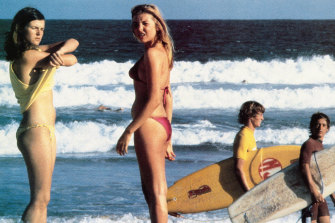
As the 1981 movie Puberty Blues revealed, surfing was once a sport boys did and girls watched.Credit:Alamy
According to surf writer Phil Jarratt, only when four-time world champion Wendy Botha posed nude for Playboy Australia in 1992 did the sport take any notice of the women. In his book, Surfing Australia: A Complete History of Surfboard Riding in Australia, Jarratt shares an icky example of his published work from the era:
“I can’t remember who won the girls’ division,” he reported from the 1983 Rip Curl Pro, “but I enjoyed meeting the sweet young things in the judging bus later on, and I thought South Africa’s Wendy Botha and Australia’s Helen Lambert were particularly foxy.”
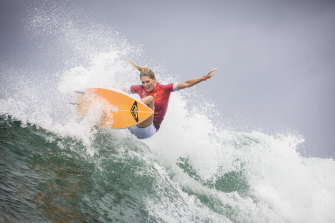
Steph Gilmore.Credit:Getty Images
These days, with sponsors like Roxy, Nikon, Sanitarium and DHD Surfboards, seven-time world champion Stephanie Gilmore can expect to earn more than $1.5 million a year, but 30 years ago female surfers had to think way beyond the beach to pay the bills. For Burridge, that meant relying on the sponsorship of a Sydney western-suburbs car yard called Asian Wreck.
Pauline Menczer was an athletic powerhouse, but couldn’t find sponsors because she didn’t fit the stereotypical blonde-haired, blue-eyed image. During her two decades on the pro circuit, she was so strapped for cash that she sometimes slept in her board bag in the event tents, buying jeans in the US and flogging them in France to fund her travel. Menczer – who grew up in Bondi – suffered crippling rheumatoid arthritis and had to pretend her girlfriend was her coach on the tour because of rampant homophobia.
In 1993, after all her sacrifices for the sport she loved, Menczer took out the world title – and won nothing but a broken trophy. Menczer’s story is probably the most poignant in Girls Can’t Surf. When Farris and her staff watched the doco, she and Rip Curl colleague Sophie Marshall were so appalled they set up a GoFundMe appeal to raise the $25,000 that Menczer – now a school bus driver near Byron Bay – should have won. (It ultimately raised just over $60,000.) “When we hit the target, Pauline sent a photo to Soph and me of her crying in the car,” says Farris. “It makes me emotional thinking about it.”
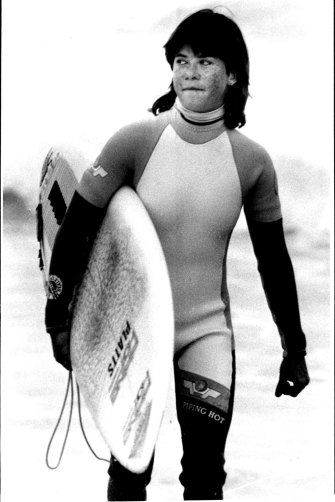
Pauline Menczer (pictured here in 1988) sometimes had to sleep in her board bag on tour due to lack of funding.Credit:Antonin Cermak
Now, with the likes of Gilmore, Sally Fitzgibbons and Tyler Wright among Australia’s top athletes, the idea that girls can’t surf is laughable, but that doesn’t mean the sexism is stamped out. As Beachley says, “We’ve still got a f…ing long way to go.” Sponsors, for example, still seem to prefer women surfers who are conventionally easy on the eye and wear minimal amounts of Lycra. When Pam Burridge was on the pro tour, she was told to lose weight to promote the sport, and later became dangerously ill with anorexia. Thirty years on, she notes that female surfers often score the most Instagram likes when they post provocative pics in skimpy swimsuits, which means there’s pressure to keep doing it – to convince their sponsors they’ve got reach.
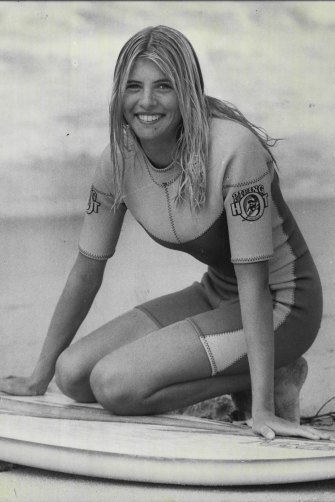
Pictured here in 1980, Pam Burridge was told to lose weight to promote surfing – and later became dangerously ill with anorexia.Credit:Russell McPhedran
“It’s super-tricky, but it’s the real world, isn’t it?” says Burridge, speaking while on patrol for the Mollymook Surf Life Saving Club on the NSW South Coast. “Just yesterday [in a Facebook group for women surfers], they were complaining that the Mick Fanning softboard brand had an ad with a bunch of girls wearing G-banger swimsuits to promote their boards. Go to the beach and all the young girls with amazing bodies are wearing those Brazilian bikinis with no butt in them, but [the company] got called out and they actually took the ad down.”
Despite its anti-establishment origins, the surfing world is remarkably conservative. Two-time world champion 27-year-old Tyler Wright faced a savage online backlash after the Tweed Coast Pro last September when she knelt in solidarity with the Black Lives Matter movement. Undeterred, she competed three months later wearing a Pride flag, an acknowledgment of her bisexuality. “She’s borne the brunt of trolling in surfing,” says Carroll. “I think it’s mostly coming from threatened young men. Those girls at the top of that tree right now – there are not too many men who can surf as well as them.”
Outspoken women have always made enemies, but female surfers now have senior women in the industry to support them, such as Farris, Beachley and ex-pro Sydney surfer Jessi Miley-Dyer, who became WSL’s head of competition this year. Tyler Wright says female mentors matter. A surfing prodigy from NSW’s Culburra Beach, Wright signed with Rip Curl at the age of eight and took out the Beachley Classic as a 14-year-old wild card, becoming the youngest surfer in history to win a Championship Tour event. Wright met Farris there and has since come to rely on her counsel; it was Farris, for example, who encouraged her to stay in school. “Any time I have an issue, I always call Brooke,” says Wright. “She’s watched me win world titles and she’s also been there when I’ve broken down.”
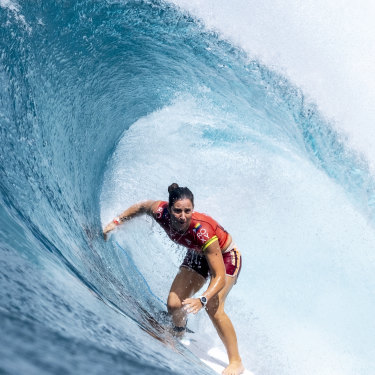
NSW prodigy Tyler Wright.Credit:Getty Images
The day Farris was made CEO in August, Wright lost a critical heat at the Corona Open Mexico, meaning she didn’t make the world top five. She had just come back from the beach, crushed and sunburnt, when Farris called. “I was quite upset and emotional,” recalls Wright, who has battled chronic fatigue syndrome since a 2018 bout of influenza. “In a business sense, I didn’t perform. I didn’t make the [Rip Curl WSL Finals], which is their event, their Super Bowl. Most of the time, when you don’t produce for your sponsor, you don’t hear from them, but Brooke was like, ‘You’ve done brilliantly this year – you’re number six in the world. Think of all the challenges you’ve faced.’ She’s someone who actually listens and cares.”
So much for the blokey boys’ club. According to Luke Kennedy, editor of the surfing magazine Tracks, “the most exciting area of surf culture – where there’s most happening – is probably among women.” Recognised or not, strong female characters have always been part of the Australian surfing scene, he says, ever since Phyllis O’Donnell won the first women’s world title in 1964; the difference now is that they’re in positions to shape surfing culture.
“What we’re seeing now is a lot more women in the water. Surfing is becoming a real symbol of women’s independence.”
One of Kennedy’s biggest surfing influences was his mother, Jenny, a maverick who surfed at Sydney’s Maroubra Beach in the late ’60s and was known as “John Balls” among her chauvinistic fellow surfers. Jenny was, apparently, once out surfing at the same time as a women’s contest, and performed so well that the judges confused her for a competitor; when she walked out of the waves, they informed her that she’d won. “What we’re seeing now is a lot more women in the water,” says Kennedy. “Surfing is becoming a real symbol of women’s independence.”
Pam Burridge, who runs a surf school on the NSW South Coast, has noticed a sharp increase over the past five years. All of her 2022 women’s surfing retreats have been booked out for months. Hardcore surfers still own the big, heavy surf spots, but soft learning boards have opened the sport up to beginners, and social groups like Surfing Mums have made the waves more welcoming.
There’s also plenty of surfwear made for women – not out of altruism, but because it makes commercial sense. Rip Curl legend has it that co-founder Brian Singer once vowed never to make female surf gear, but women’s products now account for more than 40 per cent of sales globally. Farris talks about “empathy-led design” and has introduced a new online fit guide featuring a bunch of Rip Curl employees – (at this stage, all white) women of different shapes and sizes – wearing an assortment of bikini tops and bottoms, to help customers figure out which swimsuit will fit them best.
“Women are front of mind for me because I am one,” says Farris, whose mum learnt to surf at 55.
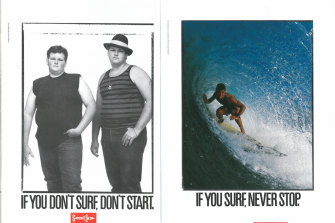
A 1980s ad for Gotcha.
All-embracing, female-friendly marketing is pretty much the antithesis of the alienating surf ads from the early days, such as Billabong’s “Only a surfer knows the feeling” campaign. Surf brand Gotcha also famously ran a series of ads with the slogan, “If you don’t surf, don’t start”. Says Carroll: “It was full-on, like saying, ‘Surfing is for a very special f…ing breed of people, mostly men. Don’t try to walk into this door because it’ll get slammed in your face.’”
Last weekend, Carroll surfed at his Sydney home beach of Newport and was joined by a motley crew of 40 board-riders: male and female, from kids to retirees. “The doors have just slowly swung open,” he says, “and it’s a really different world.”
Surfing’s inclusion in this year’s Tokyo Olympics, and high-tech wave pools that dish out perfect breaks on demand, have been big wins for the sport, but I wonder if legitimacy has come at the expense of mystique. “There’s been that perception of surfers as being dropouts and beach bums and dope-smokers, and that probably still lingers a bit,” says Tracks’s Luke Kennedy. “In one sense, surfers crave recognition outside of surf culture with something like the Olympics, [but] we also want to be part of this cool little club that no one else knows about, and we don’t want too many people to do it because it gets too crowded.”
Loading
It’s hard to nail down numbers, but Carroll – now the Australian editor for surf forecaster Surfline – says data suggest surfing participation worldwide has jumped 20 per cent since the pandemic began, with more people moving to coastal areas and looking for COVID-safe exercise. According to ActionWatch, which collects data on the surf retail sector, May 2020 sales of surfboards in the seven-to-nine-feet category rose an incredible 3665 per cent in Australia compared with the year before, thanks to new surfers and the government’s pandemic support payments. The following month, growth year-on-year was still an impressive 116 per cent. For Rip Curl, which focuses on technical products like surfboards and wetsuits but also sells swimwear, clothing and watches, sales were up 10.5 per cent for the 2020-21 financial year, despite store closures.
It’s been a boom time, and a remarkable turnaround, for the surf industry after a turbulent decade, especially for the big three homegrown labels: Rip Curl, Billabong and Quiksilver. Rip Curl began when two Torquay surf-lovers, Doug “Claw” Warbrick and Brian “Sing Ding” Singer, started making surfboards out of a garage in 1969. They recruited another local, Alan Green, to make wetsuits, but “Greeny” soon left and launched his own surf brand, Quiksilver, with John Law. On the Gold Coast, Gordon Merchant started churning out his triple-stitched Billabong board shorts in 1973, and the last of the surf trinity was born.
The brands grew into global giants and by the mid-2000s it seemed they could do no wrong – in 2007, market leader Quiksilver reported a gobsmacking turnover of $US2.4 billion – but then came the global financial crisis, consumer tastes changed, and the surfwear industry took a dive. In 2013, Billabong announced a loss of $860 million. Quiksilver filed for bankruptcy in 2015, before being bailed out by US private equity giant Oaktree Capital Management, which went on to acquire the ailing Billabong in 2018. Both brands are now owned by Oaktree’s portfolio company Boardriders.
Rip Curl managed to escape the financial bloodbaths of its rivals, largely because it stuck to its surfing roots, focusing more on wetsuits and surfboards. Its sales shrank in the 2010s, too, but it wasn’t quite as vulnerable when beach style gave way to athleisure and the surf brands faced competition from cheaper fashion alternatives like Zara and H&M. Rip Curl also hadn’t listed on the stock exchange and gone on an acquisition spree like Quiksilver and Billabong. “Going public seemed to go to the big surf companies’ heads,” says Carroll. “There was so much money sloshing around, they just lost the plot.”
Beyond that, though, there was a sense that the international labels had sold out. They diluted their brands by marketing to the masses, selling their gear to non-surfers in shopping centres thousands of kilometres from the coast. Despite their laid-back, counterculture roots, the big brands had gone full corporate, and it didn’t go down well with surfers. “The bigger they got in volume and range, and the more mainstream they became, the less engaging they were for their core audience,” says Retail Doctor Group CEO Brian Walker, a director of the Surf and Boardsports Industry Association. “If I can buy Quiksilver T-shirts in Target, it’s not aspirational.” Once the scarcity value is lost, smaller independent labels from surfing communities fill the breach.
Walking that line between profitability and credibility is difficult, which is why sponsoring top surfers and competitions is crucial. Carroll says that the big labels have learnt their lesson: “For a lot of surf companies now, it’s about keeping your head down and just making good product,” he says. “Quiksilver and Billabong are still going fine; they’re just not making $2.5 billion a year any more. They’re making a lot less and they’re not boastfully swingin’ it around.”
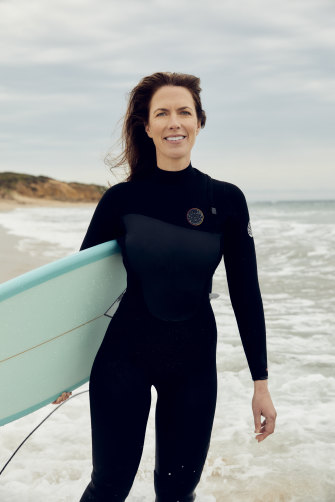
Farris taking to the Torquay surf.Credit:Cory White
As for Rip Curl, it hasn’t all been smooth sailing: in 2016, it was revealed the company had used a North Korean factory with slave-like working conditions to make clothes labelled “Made in China”. Rip Curl apologised, blaming a supplier for diverting some of its production order to an unauthorised subcontractor. Two years ago, NZ outdoor retailer Kathmandu bought Rip Curl for $350 million, making it the last of the iconic Australian surf labels to become foreign-owned.
“I’ve never met anyone who comes out of the water and says, ‘Oh, I wish I hadn’t gone for a surf.’ You always feel better for it.”
For Farris, the challenge will be to preserve the mystique of surfing while making it more accessible, welcoming newcomers and perhaps even creating a fresh surf culture along the way. It’s a tricky balancing act. “You still want to be cool enough to recruit that next generation, but I think by approaching it from a place of inclusivity, people will be attracted to that,” she says. “I’d rather see more people try surfing because … I’ve never met anyone who comes out of the water and says, ‘Oh, I wish I hadn’t gone for a surf.’ You always feel better for it.”
Loading
I can vouch for that. After the surf lesson with Farris, I wrestle my way out of the wetsuit in the toilet block and walk back to the beach carpark, where a trio of friendly, middle-aged men are changing next to a four-wheel drive, peeling off wetties and pulling undies up under their towels, as they’ve done no doubt countless times over the past five decades. As the men laugh together, their grey hairs and soft bellies seem to disappear, and I get a glimpse of their younger, cooler, more carefree selves. Still zinging after a session in the icy Torquay surf, the men look stoked – and suddenly, surfing all makes sense.
To read more from Good Weekend magazine, visit our page at The Sydney Morning Herald, The Age and Brisbane Times.
The best of Good Weekend delivered to your inbox every Saturday morning. Sign up here.








